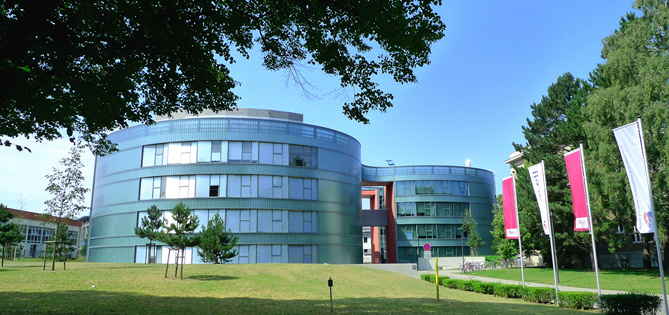J Exp Clin Cancer Res. 2019 Jul 8;38(1):292. doi: 10.1186/s13046-019-1286-9.
Rewiring E2F1 with classical NHEJ via APLF suppression promotes bladder cancer invasiveness.
Richter C, Marquardt S, Li F, Spitschak A, Murr N, Edelhäuser BAH, Iliakis G, Pützer BM, Logotheti S.
BACKGROUND:
Bladder cancer progression has been associated with dysfunctional repair of double-strand breaks (DSB), a deleterious type of DNA lesions that fuel genomic instability. Accurate DSB repair relies on two distinct pathways, homologous recombination (HR) and classical non-homologous end-joining (c-NHEJ). The transcription factor E2F1 supports HR-mediated DSB repair and protects genomic stability. However, invasive bladder cancers (BC) display, in contrast to non-invasive stages, genomic instability despite their high E2F1 levels. Hence, E2F1 is either inefficient in controlling DSB repair in this setting, or rewires the repair apparatus towards alternative, error-prone DSB processing pathways.
METHODS: RT-PCR and immunoblotting, in combination with bioinformatics tools were applied to monitor c-NHEJ factors status in high-E2F1-expressing, invasive BC versus low-E2F1-expressing, non-invasive BC. In vivo binding of E2F1 on target gene promoters was demonstrated by ChIP assays and E2F1 CRISPR-Cas9 knockdown. MIR888-dependent inhibition of APLF by E2F1 was demonstrated using overexpression and knockdown experiments, in combination with luciferase assays. Methylation status of MIR888 promoter was monitored by methylation-specific PCR. The changes in invasion potential and the DSB repair efficiency were estimated by Boyden chamber assays and pulse field electrophoresis, correspondingly.
RESULTS: Herein, we show that E2F1 directly transactivates the c-NHEJ core factors Artemis, DNA-PKcs, ligase IV, NHEJ1, Ku70/Ku80 and XRCC4, but indirectly inhibits APLF, a chromatin modifier regulating c-NHEJ. Inhibition is achieved by miR-888-5p, a testis-specific, X-linked miRNA which, in normal tissues, is often silenced via promoter methylation. Upon hypomethylation in invasive BC cells, MIR888 is transactivated by E2F1 and represses APLF. Consequently, E2F1/miR-888/APLF rewiring is established, generating conditions of APLF scarcity that compromise proper c-NHEJ function. Perturbation of the E2F1/miR-888/APLF axis restores c-NHEJ and ameliorates cell invasiveness. Depletion of miR-888 can establish a 'high E2F1/APLF/DCLRE1C' signature, which was found to be particularly favorable for BC patient survival.
CONCLUSION: Suppression of the 'out-of-context' activity of miR-888 improves DSB repair and impedes invasiveness by restoring APLF.
Bladder cancer progression has been associated with dysfunctional repair of double-strand breaks (DSB), a deleterious type of DNA lesions that fuel genomic instability. Accurate DSB repair relies on two distinct pathways, homologous recombination (HR) and classical non-homologous end-joining (c-NHEJ). The transcription factor E2F1 supports HR-mediated DSB repair and protects genomic stability. However, invasive bladder cancers (BC) display, in contrast to non-invasive stages, genomic instability despite their high E2F1 levels. Hence, E2F1 is either inefficient in controlling DSB repair in this setting, or rewires the repair apparatus towards alternative, error-prone DSB processing pathways.
METHODS: RT-PCR and immunoblotting, in combination with bioinformatics tools were applied to monitor c-NHEJ factors status in high-E2F1-expressing, invasive BC versus low-E2F1-expressing, non-invasive BC. In vivo binding of E2F1 on target gene promoters was demonstrated by ChIP assays and E2F1 CRISPR-Cas9 knockdown. MIR888-dependent inhibition of APLF by E2F1 was demonstrated using overexpression and knockdown experiments, in combination with luciferase assays. Methylation status of MIR888 promoter was monitored by methylation-specific PCR. The changes in invasion potential and the DSB repair efficiency were estimated by Boyden chamber assays and pulse field electrophoresis, correspondingly.
RESULTS: Herein, we show that E2F1 directly transactivates the c-NHEJ core factors Artemis, DNA-PKcs, ligase IV, NHEJ1, Ku70/Ku80 and XRCC4, but indirectly inhibits APLF, a chromatin modifier regulating c-NHEJ. Inhibition is achieved by miR-888-5p, a testis-specific, X-linked miRNA which, in normal tissues, is often silenced via promoter methylation. Upon hypomethylation in invasive BC cells, MIR888 is transactivated by E2F1 and represses APLF. Consequently, E2F1/miR-888/APLF rewiring is established, generating conditions of APLF scarcity that compromise proper c-NHEJ function. Perturbation of the E2F1/miR-888/APLF axis restores c-NHEJ and ameliorates cell invasiveness. Depletion of miR-888 can establish a 'high E2F1/APLF/DCLRE1C' signature, which was found to be particularly favorable for BC patient survival.
CONCLUSION: Suppression of the 'out-of-context' activity of miR-888 improves DSB repair and impedes invasiveness by restoring APLF.

Contact
Institute of Experimental Gene Therapy and Cancer Research
Core-Facility Viral Vector & Genome-Editing Technologies
Biomedical Research Center
Schillingallee 69
D-18057 Rostock
Office
Ingrid Winkler
(+49) 381 494-5066(+49) 381 494-5062
ingrid.winkler@med.uni-rostock.de
Department Life, Light & Matter
Research Building LL&M
Albert-Einstein-Str. 25
D-18059 Rostock
Research Building LL&M
Albert-Einstein-Str. 25
D-18059 Rostock




